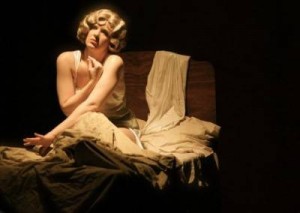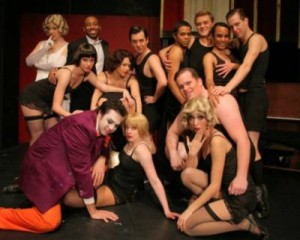RECOMMENDED
Just like the kids who pooled their talents to “put on a show” in 1939’s Mickey Rooney-Judy Garland flick Babes In Arms, so the young 21st Century performers of Still Hungry Theatre have banded together to stage Andrew Lippa’s The Wild Party on a shoestring—with commendable results.
Musical theater aficionados know that there are two song-and-dance versions of Joseph Moncure March’s 1928 epic poem, the 2000 Broadway show with music and lyrics by Michael John LaChiusa, and the 2000 off-Broadway version with music and lyrics by Lippa. Both shows deal with the same love quadrangle and both begin with a song which features the poem’s opening lines, “Queenie was a blonde and her age stood still, and she danced twice a day in vaudeville. Queenie was a blonde, and if looks could kill, she would kill twice a day in vaudeville.”
The basic plot of both is simple. Platinum blonde entertainer Queenie and her abusive lover of seven years, Burrs, throw a party for their friends: lesbian Madelaine True, pugilist Eddie, “sweet dancer” Jackie, pianist-composers Oscar and Phil D’Armano, hooker Dolores, “looker” Mae, and Nadine—a minor. Things start out wild and get even wilder when a firecracker named Kate arrives with her latest flame, Black. Black and Queenie hit it off—with tragic consequences.
LaChiusa’s version fleshes out the stories of the dozen or so party guests and features a 1920s flavored (and to many ears discordant) score, while Lippa’s Wild Party focuses mainly on the mismatched pairs of lovers and includes many showstoppers (“Let’s Raise The Roof,” “A Wild Wild Party,” etc.) with a more contemporary feel.
Under Sam Cavanaugh’s solid direction, Still Hungry’s The Wild Party opens with Queenie (Laura Thatcher) surrounded by male admirers in black wife-beaters and undershorts belting out “Queenie Was A Blonde.” Queenie and Burrs (Keith Barletta) then duet “Out Of The Blue,” which expresses just how soured their relationship has become. (“Out of the blue, I wish a bolt of lighting would hit. How many years have passed me by, wishing, waiting? How many hopes have left me dry? Just irritating.)
Then, in the evening’s most imaginatively staged sequence, “What A Party” introduces the guests, lit only by their hand-held flashlights which alternately illuminate faces, shine out into the audience, and perform a highly creative light show with their beams.
Unlike LaChiusa’s The Wild Party, Lippa’s version gives only three of the peripheral characters their own songs. Madelaine takes the spotlight for the racy, hilarious “An Old Fashioned Love Story.” (“I need a good-natured, old-fashioned lesbian love story, the kind of tale my mama used to tell.”) Mountainous Eddie and diminutive Mae duet “Two Of A Kind” about their highly mismatched coupledom. (“She’s a one-two punch, he’s a catered lunch. She’s a melon, I’m the rind. He’s one of the good guys, and we’re two of a kind.”)
Most of the evening belongs to Queenie, Burrs, Kate, and Black, however, with each character getting several occasions to either belt or croon before the final, explosive gunshot-fueled climax.
The best (though far from the only) reason to see this production is Thatcher’s Queenie. This is the seventh show in which I’ve seen the former Miss Fullerton and Cal State Fullerton grad, including her breakout performance as The Wild Party’s Kate two years ago. Now she tackles the lead role with stellar results. Gorgeous, statuesque, and with a voice that can belt out high notes as effortlessly as she sang them coloratura in last year’s Thoroughly Modern Millie, Thatcher doesn’t even need a spotlight to shine as Queenie. She has powerful dramatic moments, as well, but I’ll most remember Thatcher’s Queenie as the best I’ve heard sung since Tami Tappan Damiano dazzled in the role in 2004.
USC senior Barletta is in fine form as Burrs, a role which showcases his strong singing as well as his acting chops. Appropriately over-the-top when needed, Barletta’s Burrs is both menacing and tragic. The other standout lead is UCLA musical theater major Cari Satre, quirky and winning as Kate, and with some very good pipes to boot. Howard Henley (Black) shows off a lovely voice in “Poor Child” and “I’ll Be Here,” though more power would benefit the role.
A number of supporting performances are worthy of mention, particularly Matisse Andrews’ sexy, funny turn as Madelaine, Casey Garritano’s graceful dancing as Jackie, the charmingly mismatched Topher Mauerhan and Ashley Matthews as Eddie and Mae, and the perfectly matched D’Amato brothers, Eric De Anda and Hassan Sayyed, stealing every flamboyant Oscar and Phil moment. Completing the fine young cast, almost all of whom are university or post-grad age, are Kelsey Bullock (Nadine), Robert Glen Decker (Sam), Katt Dreyfus (Dolores), and Michael Marchak (Max).
Dan Watt has choreographed quite a few lively numbers which the cast execute commendably. These include the Latin-themed “Raise The Roof,” the frantic “The Juggernaut,” and the frenetic “Let Me Drown.” Garritano’s choreography shines in “Come With Me,” an orgiastic number in which cast members disrobe down to their undies and copulate in various permutations including some same gender couplings and triplings. (This is not a show for the kiddies.)
Songs are performed to prerecorded tracks, with orchestrations by TJ Dawson, projected from rear-of-house speakers at a volume which often overpowers the cast’s unmiked voices in solo numbers, especially when sung towards the stage left and right walls. Considerable dialog may also be lost to audience members unfamiliar with The Wild Party due to the volume of the show’s underscoring and the positioning of the speakers. Under James Post’s excellent vocal direction, however, ensemble numbers sound great and are powerful enough to mix well with background tracks.
Andrew Potvin’s lighting is particularly effective, combining front and back lighting, a follow spot, hanging bulbs, a fine use of color, and those aforementioned flashlights. Troy Olschewske’s simple set design reflects the production’s budget limitations, but makes good use of the Ruby Theatre’s stage left staircase. Costumes courtesy of Crystal Cruises have a terrific 1920’s look. Nicole Rossi serves as stage manager and assistant director.
All involved in this production deserve kudos for their enthusiastic efforts and the show’s creditable results. Still Hungry Theatre’s The Wild Party provides a fine showcase for fourteen of Los Angeles’ young musical theater talents.
Ruby Theater in The Complex, 6476 Santa Monica Blvd., Hollywood.
www.stillhungrytheatre.com
–Steven Stanley
March 12, 2010




 Since 2007, Steven Stanley's StageSceneLA.com has spotlighted the best in Southern California theater via reviews, interviews, and its annual StageSceneLA Scenies.
Since 2007, Steven Stanley's StageSceneLA.com has spotlighted the best in Southern California theater via reviews, interviews, and its annual StageSceneLA Scenies.







 COPYRIGHT 2024 STEVEN STANLEY :: DESIGN BY
COPYRIGHT 2024 STEVEN STANLEY :: DESIGN BY